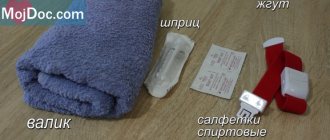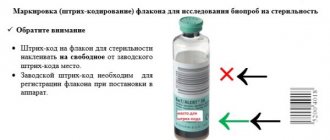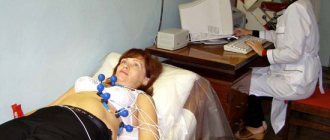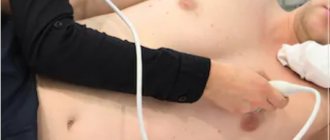Features and advantages of vacutainers
The three-component system for venous blood collection consists of:
- sterile vacuum tube with preservative;
- double-sided automatic needle for intravenous injection;
- automatic needle holder.
The advantages of negative pressure systems are related to their design features:
- safety, sterility and guarantee of sample integrity;
- minimizing microclots and hemolysis;
- maintaining a constant time between collection and connection with the additive;
- exact ratio of sample and additive;
- minimizing the tourniquet effect.
Varieties
The test tubes have caps of different colors. Each analysis has a specific color and internal filler. A tube with a purple cap is used for PCR studies. The essence of this research is the use of special enzymes that repeatedly copy DNA and RNA fragments of diseases found in blood samples. This method is mainly used to diagnose diseases such as tuberculosis, herpes, HIV and others. Blood is also taken when a hematological study is to be performed in order to obtain information about the quantitative and qualitative composition. The system with a blue lid is designed for analysis that determines blood clotting. A powerful anticoagulant is added to the test tube - sodium citrate solution 3.2% or 3.8%. A blue tube is taken when it is necessary to analyze microelements. The required amount of heparin salt is added to the green-topped test tube.
They are used to test blood for:
- gas composition;
- presence of alcohol;
- electrolyte composition.
Blood is collected using a vacuum tube with a brown or red cap if necessary to conduct serological and biochemical studies. The special internal spray contains blood serum. Glucose levels are determined using a gray test tube. A test tube with a pink cap is used in cases where it is necessary to conduct research during blood transfusion, and with an orange cap, serum is examined.
Algorithm for taking blood using a vacuum system
The method of collecting venous blood with vacuum tubes is similar to using a syringe, but provides greater safety, efficiency and convenience. The collection is carried out quickly, which is important to guarantee an accurate research result.
When collecting blood from a peripheral vein using a vacuum system, you will need:
- vacuum tubes;
- tourniquet;
- cotton wool (cotton swabs) or napkins;
- antiseptic (medicinal alcohol);
- bactericidal patch;
- sterile medical tray;
- medical clothing (gown, goggles, mask and gloves).
Before the procedure, it is necessary to fill out a patient referral, treat your hands with a special solution, and put on protective medical clothing.
Technique for collecting blood from a vein
- Prepare test tubes that correspond to the stated tests or laboratory tests required by the patient, a needle, a holder, alcohol wipes or a cotton swab, and a patch.
- Place a tourniquet on the patient's shirt or diaper 7-10 cm above the venipuncture site. Ask the patient to make a fist.
- Select a venipuncture site. The middle ulnar and saphenous veins are the most commonly used, but smaller and more plethoric veins of the dorsum of the wrist and hand can also be punctured.
- Take the needle and remove the cap from the rubber membrane side. Insert the needle into the holder and screw it in until it stops.
- Disinfect the venipuncture site with a gauze pad. You must wait until the antiseptic solution has completely dried.
- Remove the protective cap on the other side. Insert the holder-needle vacuum system into the vein in accordance with the algorithm for conventional blood collection using a syringe. Make sure that the needle is cut upward at an angle of 15º relative to the surface of the skin. Since the other end is covered with a membrane, blood does not flow through the needle. Using smooth and quick movements, the skin and vein wall are punctured. Deep immersion of the needle should be avoided.
- Insert the test tube as far as it will go into the holder. As a result, the needle pierces the membrane and the plug, and a channel is formed between the vacuum tube and the vein. The needle should not be moved when blood begins to flow. The process continues until the vacuum in the test tube is compensated.
- The tourniquet should be removed or loosened as soon as blood begins to flow into the vacutainer. Make sure the patient unclenches their fist.
- After the blood flow stops, the tube is removed from the holder. The membrane returns to its original position, the blood flow through the needle is blocked. If necessary, other tubes can be connected to the holder to collect the required volume of blood. Immediately after filling, the test tube must be carefully inverted to mix the sample with the filler: test tube without anticoagulants - 5-6 times; test tube with citrate - 3-4 times; test tube with heparin, EDTA and other additives - 8-10 times.
- After filling the last tube, disconnect it from the holder and remove the holder-needle system from the vein. To ensure safety, remove the needle from the holder and place it in a special container for disposal.
- A sterile napkin/cotton ball moistened with an antiseptic is applied to the puncture site, or a bactericidal patch is applied.
- The tubes are labeled and placed in a special container for transportation to the laboratory.
Description of the vacutainer
The BD Vacutainer is a disposable device designed specifically for collecting blood from a vein. The device also has another name: vacutainer. The set consists of:
- test tubes with a tight screw cap;
- sterile disinfected needle;
- adapter holder.
To collect, transport and preserve biological material, a container is used, inside of which there are various reagents and a vacuum. Excipients are necessary to obtain the desired material, namely serum, plasma and whole blood. The lid body is plastic and unbreakable, and the stopper is made of rubber. Air is not able to penetrate inside; the biomaterial is reliably protected. There are standard holders, elongated ones, and those that automatically reset the needle. The tubes have markings that indicate what each one is for.
Possible errors when using vacuum tubes
| Problem | Possible reasons | Solution |
| Blood does not flow into the tube after connecting to the holder | The needle did not enter the vein | In all of these cases, it is necessary to carefully adjust the position of the needle. There is no need to disconnect the tube from the holder if there is no need to remove the needle and under the skin. |
| The tip of the needle rests against the venous wall | ||
| The vein is pierced through | ||
| The blood in the test tube was received in less quantity than required for the analysis. | The venous vessel collapsed due to low pressure | It is necessary to disconnect the tube from the holder and wait a while until the vein is filled again |
| The system needs to be replaced and the procedure repeated | Air got into the test tube |
You can order high-quality laboratory consumables. When collecting blood using a vacuum system, follow the algorithm. This will ensure the safety of the procedure and the reliability of the research results.
Main advantages
Unlike a disposable syringe, a vacutainer has many advantages, the most important thing is that the system guarantees the accuracy of the study.
In this case, there is no need to transfuse biological material, so its contact with hands or air is excluded. The danger of infection to the laboratory assistant is eliminated. The analysis is carried out directly from the device. There are different types of vacutainers that are used for various laboratory tests. All test tubes are numbered, so it is impossible to replace or mix them up. The vacuum timer system is made of plastic that does not break. The procedure takes 10-15 seconds. The patient's veins are not injured. Attention! If you need to carry out more than one examination at once, then you just need to change the container.
Blood collection scheme
Taking blood using a vacuum system is almost no different from the procedure performed with a simple syringe. Comfort and safety is explained by the fact that when the biomaterial flows into the test tube, a volumetric vacuum is formed. It allows you to take the required amount of exclusively sterile biomaterial. When working with the device, it is important to adhere to the correct scheme. First, the nurse unseals the vacutainer and removes the cap from the disposable needle.
How much does the system cost?
Vacuum systems are sold in pharmacies, available without a prescription, their cost depends on:
- test tube volume;
- country of origin;
- filler-reagent.
The approximate cost of test tubes varies from 7.5 to 13.5 rubles per 1 piece. One needle holder costs approximately 4 rubles. The price of a standard double-sided vacuum needle and its other types is about 6 rubles.
Vacutainers must be stored correctly. Vacuum systems are deformed by temperature changes and do not tolerate cold. Before use, they should be brought into a room at room temperature in advance and kept there for 48 hours. Based on laboratory data obtained using a vacuum system, it will be easier for the doctor to make the correct diagnosis, which is necessary to prescribe adequate therapy.
Why is it important to use vacuum systems?
Laboratory diagnostics is carried out in three stages:
- Preanalytical.
- Analytical.
- Post-analytical.
The duration of the stages and the degree of their influence on the reliability of the data are different.
The longest is the first stage, occupying two-thirds of the duration of any study. Errors made at the preanalytical stage lead not only to an increase in time spent on making a diagnosis, but also to unnecessary waste of budget funds due to the appointment of a repeat procedure. They affect the entire process of correct diagnosis and evaluation of therapy.
The degree of reliability of the data obtained depends on a huge number of variables:
- personal characteristics of a person (gender, age, race, etc.);
- features of eating behavior before submitting laboratory material (fasting, abuse of a certain type of food, etc.);
- intensity of physical and emotional stress;
- natural changes in hormonal levels (phases of the menstrual cycle, pregnancy, menopause, etc.);
- weather and climatic conditions;
- medicines taken by humans;
- position of the patient at the time of material collection.
In addition to the above, the accuracy and correctness of the results depends on the technique of taking blood from a vein, the instruments used for this, the conditions of transportation and storage of the collected material.
When collecting blood from a vein using needles or syringes, it is impossible to standardize the technology for collecting the material. Using needles to collect venous blood can result in the collected material and pathogens of bloodborne infections getting into the hands of medical staff. This creates the danger of further transfer of pathogens to other patients. Taking biomaterial with a syringe practically eliminates this possibility, but when transferring it from a syringe to a test tube, hemolysis of red blood cells caused by mechanical action is possible.
Taking venous blood with a syringe does not exclude contact of medical staff with the patient’s blood and is therefore unsafe
Thus, vacuum systems have become the optimal tool for collecting venous blood.










